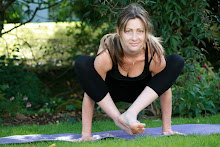A few of you have been asking me recently about meditation techniques so I have re-posted the technique below as written by Shiva Rea for Yoga Journal. This is a technique I have used and found helpful. I have found the best time, for me, to meditate is after I have practised asana. Meditation is, like asana, all about practice so don't expect to be able to just sit down and be meditating. I have been doing it for two years now and still struggle most of the time. Every now and then I get maybe a couple of seconds of mental stillness and it's all worth it!
I have found that meditation is very much about your attitude towards it. If you are sitting there thinking I could be doing something else, this is a waste of time, you will very quickly stop the whole exercise. In the beginning try to look at it as a period of time for yourself to sit, relax and do nothing physically. For most of you I know that in itself will be a treat, so try to think of it as such. If you have a positive attitude towards it you will relax much more easily. In time the stilling of the mind will come. As I said above, I only manage a few seconds every now and again, but I feel sure if I continue I will get better at it.
Let me know how you get on.
Enjoy
Jo x
Higher Hum: Breath and Mantra Meditation
The following meditation is based upon the mantra "so hum," ("I am that") used within the traditions of Tantra and Vedanta.
By Shiva Rea.
Mantra, the chanting of sacred words or sounds, is a central part of yogic meditation. Mantra comes from the combination of two syllables: "man," meaning "to reflect" or "be aware," and "tra," meaning "tool for" or "agent of." A mantra is a tool for reflection and the cultivation of awareness, and is used for both concentration and contemplation on the Source.
Within yoga, mantras are based upon sounds that reflect the energy of our divine nature. Om is considered to be the universal, consummate mantra. The following meditation is based upon the mantra "so hum," ("I am that") used within the traditions of Tantra and Vedanta. Since "so hum" also indicates the sound of the breath, it is a mantra that repeats itself effortlessly.
Find a comfortable posture for meditation (seated on a cushion or blanket, in a chair or against a wall). Place your palms facing up in jnana mudra (forefinger and thumb touching) with your palms facing up to open your awareness or facing down to calm the mind. Scan your body and relax any tension. Let your spine rise from the ground of the pelvis. Draw your chin slightly down and let the back of your neck lengthen.
Bring your attention to the tidal rhythm of your breath, feeling the rise and fall of your inhalation and exhalation. As your focus settles on your breath, begin to employ the simple mantra "so hum." As you inhale, say "so" silently to yourself, and as you exhale say "hum." Keep your focus on the sensation of your breath while silently repeating the sacred syllables, "so hum." As you drink your inhalation, gently drawing your breath along the base of your throat, listen for the sound of "so." As you exhale, listen for the sound of "hum" as your breath is amplified in the throat.
Let your mind become absorbed in the sound of so hum-in your internal chanting and your actual breath. As if you were watching the waves of the ocean, let your mind be naturally drawn into presence and stillness—no place to go, nothing to do, so hum, so hum. If a thought (vritti) arises, come back to the mantra so hum.
In the beginning, it may be helpful to set an external timer for 10, 20, or 30 minutes so you are not distracted. When you are finished, bring your hands together in anjali mudra (prayer position) and close with a moment of gratitude, reflection, or prayer to soak up the energy of your meditation into your being and life.







